Engineers and the Two Taiwans: The Abnormal Club
Springer Cham, 2025
Kuo-Hui Chang, National Taiwan University
Gary Lee Downey, Virginia Tech
Bono Po-jen Shih, Pennsylvania State University
Abstract for scholars: Engineers do politics even when they avoid partisan politics. They do it through material commitments. This book, an experiment in critical participation, shows how. Local engineers and would-be engineers in Taiwan had found ways of climbing hierarchical infrastructures established by Japanese colonialists and then an arriving Kuomintang government by founding small companies. Islander engineers continued this practice into the 1970s, complementing the work of mainlander engineers in large, state-supported companies to produce an electronics industry structured differently than those in Japan and Korea. The Abnormal Club was a small group of mainlander and islander graduate students who stayed in Taiwan for graduate school and work in electronics rather than go to the United States. Their collaboration in learning despite different geographical identities became a metaphor for the greater cooperation in industry that effectively disrupted the hierarchy of mainlanders over islanders in Taiwan and laid the material groundwork for democratization in the 1980s and beyond. Yet the land of Taiwan they helped to animate was actually two different Taiwans, one linked to the Republic of China and the other a thing unto itself. The separation between mainlander and islander engineers re-emerged when both crossed the Strait of Taiwan, which also raised the specter of a third Taiwan. The abnormal club was gone but the privileges engineers had earned in the process assigned them responsibilities in the present. A commitment to provide material benefits for all can now be a strategic goal rather than a naïve one.
experiment in critical participation, shows how. Local engineers and would-be engineers in Taiwan had found ways of climbing hierarchical infrastructures established by Japanese colonialists and then an arriving Kuomintang government by founding small companies. Islander engineers continued this practice into the 1970s, complementing the work of mainlander engineers in large, state-supported companies to produce an electronics industry structured differently than those in Japan and Korea. The Abnormal Club was a small group of mainlander and islander graduate students who stayed in Taiwan for graduate school and work in electronics rather than go to the United States. Their collaboration in learning despite different geographical identities became a metaphor for the greater cooperation in industry that effectively disrupted the hierarchy of mainlanders over islanders in Taiwan and laid the material groundwork for democratization in the 1980s and beyond. Yet the land of Taiwan they helped to animate was actually two different Taiwans, one linked to the Republic of China and the other a thing unto itself. The separation between mainlander and islander engineers re-emerged when both crossed the Strait of Taiwan, which also raised the specter of a third Taiwan. The abnormal club was gone but the privileges engineers had earned in the process assigned them responsibilities in the present. A commitment to provide material benefits for all can now be a strategic goal rather than a naïve one.
Abstract for engineers and other readers: The identity of Taiwan is a matter of intense local and international debate. This book shows how engineers helped produce two distinct visions of the land of Taiwan and its people, elevating the value of engineering as a career path in the process. The book describes how the technical work of engineers, which typically avoids partisan politics, can actually contribute to partisan differences and conflict. In most countries, the rise of engineering is about the emergence of a single dominant vision of the country. In Taiwan, two distinct visions of the land and its people emerged, owing to the presence of two distinct geographical identities—islanders and mainlanders. The distributed mode of production in the electronics industry proved to be transformative and created an “abnormal boys’ club” of engineers, as one group called themselves. Because the two communities were influenced by contrasting geographical identities, they felt as though they were working for different Taiwans.
Endorsements for Engineers and the Two Taiwans
“What a book. Engineers and the Two Taiwans traces how engineers creatively crafted professional identities and pathways in the cracks of multiple, shifting empires – and in so doing helped create Taiwan as a thing-unto-itself. In showing how engineers shaped and were shaped by geopolitics and the birth of a new electronics industry, the book opens up fresh perspectives on longstanding questions about who engineers are, how they are trained, where they ought to work, and ultimately what engineering is for. These engineers did politics through their material commitments even as they avoided partisan politics.”
Jessica M. Smith, Editor-in-chief, Engineering Studies, Professor, Engineering, Design, and Society Department, Colorado School of Mines
“This book explores Taiwan’s dynamic industrial evolution over the past century through the lens of different engineers’ social dynamics, identity, values, and compelling narratives. It offers insights into Taiwanese own perceptions in the electronics industry and prompts reflection on how countries navigate domestic and international technology policies and social progress. You will come to appreciate how engineers in Taiwan today bear continuing responsibilities to connect their technical work to its land and people, even when their own commitments differ from one another.”
Minn-Tsong Lin, Deputy Minister, National Science and Technology Council, Taiwan, Distinguished Professor, Department of Physics, National Taiwan University
Contents
Chapter 1: Abnormal Engineers for an Abnormal Land
An experiment in attaching learning from STS
Opening up infrastructures of engineering formation and work
A tension on the frontier
References
Chapter 2: Freelancing around Japanese Infrastructures
Common school knowledge for the underside of industry
Industrial knowledge to climb up . . . or out?
Spectators of industrial expansion
Climbing around Japanese governance
References
Chapter 3: Climbing Mainland Infrastructures
Arriving ethical knowers for national reconstruction
Not accepted as knowers for reconstruction
Degreed engineers flow into government infrastructures
Bringing national reconstruction to education
Climbing from the underside, again
References
Chapter 4: Animating Two Taiwans
Mainlanders lead through METS, ITRI & EIRC
Mainlanders lead through Hsinchu Park and the Ten Major Construction Projects
Islanders fill the gaps
Multiplying engineering technicians and engineers
Electronics elevates islander engineers
References
Chapter 5: Two Taiwans in the U.S.
The “C” camp
The “F” to “T” camp
The low-profile camp
Shifting competition as Taiwan becomes a thing
References
Chapter 6: The Separation Crosses the Strait
The multiplication of local engineers
The return of engineers
Crossing the Strait on two pathways
Maintaining productive power in Taiwan
Building productive power with China
Centering productive power in China
References
Chapter 7: To the Engineers of Taiwan, Past and Present
Making & Doing: Activating STS through Knowledge Expression and Travel
MIT Press, 2021 (open access here)
Edited by:
Gary Lee Downey, Virginia Tech
Teun Zuiderent-Jerak, Athena Institute, Vrije Universiteit Amsterdam
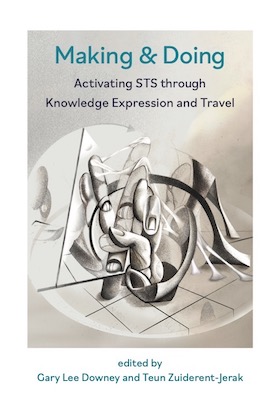 Making & doing projects expand STS scholarship to include the trajectories of STS knowledge flow beyond the boundaries of the field by actively interweaving knowledge expression and travel with knowledge production. In this edited volume, contributors from around the world present and critically assess ten empirical making & doing projects. They recount how their projects advance STS, and describe how they themselves learn from their interlocutors and the settings in which they do and share their STS work. A coda explains how the infrastructures of STS scholarship are broadening to include practices of making & doing.
Making & doing projects expand STS scholarship to include the trajectories of STS knowledge flow beyond the boundaries of the field by actively interweaving knowledge expression and travel with knowledge production. In this edited volume, contributors from around the world present and critically assess ten empirical making & doing projects. They recount how their projects advance STS, and describe how they themselves learn from their interlocutors and the settings in which they do and share their STS work. A coda explains how the infrastructures of STS scholarship are broadening to include practices of making & doing.
The contributors examine and reflect upon their dilemmas, frustrations, and failures, especially when these generate new practices that might not have occurred had their work not taken the form of making & doing scholarship. While each project raises a distinct set of scholarly issues, all of the projects include practices that express STS knowledge through “STS sensibilities” and attach those sensibilities to practices in empirical fields. The ten projects include one each in Argentina, Taiwan, Canada, and Denmark; two in the US; one in Austria, the UK, and multiple countries in Africa and Asia; one in the US and Latin America; one in the Netherlands and Australia; and one in an international network that includes members from Europe, the Americas, and Australia.
Endorsements for Making & Doing
“Making & Doing advances a critical science and technology studies that endeavors to be reflexive, collaborative, and publicly engaged—and, therefore, that can truly matter. These timely, experimental perspectives boldly challenge STS dogma, and elucidate crucial new pathways for scholarship.”
Alondra Nelson, President, Social Science Research Council
“Richly populated with researchers and their interlocutors, these accounts describe (often uneasy) relations and always contingent practices of knowledge creation. They connect up multiple modes of scholarship with differently mediated forms of intervention and question their uneven valuation. Read together, the ten evocative cases collected here stand as ‘demo accounts’ for what is itself a transformative project-in-process for STS.”
Lucy Suchman, Professor Emerita, Lancaster University
“Making & Doing is an exceptional book. Gary Downey and Teun Zuiderent-Jerak invite the reader to join them on a fascinating trip to ten different sites where STS knowledge moves beyond the boundaries of the field. Carefully brought together, the essays fill a gap between STS research and STS in action, opening up a space of reflexive learning from engagements in empirical arenas. The book is highly innovative and inspiring as it encourages the reader to understand knowledge expression and travel not as lying outside of the core of STS scholarship but as essential and lively activities at the very heart of the field.”
Ulrike Felt, Professor, University of Vienna
“STS has always gone beyond critique to ask how knowledge and technical practices might be made differently. In response, making & doing practices have rapidly grown as a scholarly genre that puts urgent questions of ethics and methods in the spotlight. Assembled by two leaders in the field and gathering some of the most thought-provoking practitioners, this book places making & doing in its rightful location at the center of STS futures.”
Michelle Murphy, Professor, University of Toronto
Contents
Introduction: Activating STS through STS Sensibilities
Gary Lee Downey and Teun Zuiderent-Jerak (open access here)
1: STS on the Street and at the Court: Interlocutors in the Taiwan RCA Collective Occupational Disease Lawsuit
Yi-Ping Lin and Hsin-Hsing Chen
2: The Ground Keeps Opening Up: Building an Infrastructure for Data Appropriation
Dawn Nafus
3: A Shifting Incubation: From Exhibiting Academic Migration to Staging Interactions with Academic Refugees
Michael Guggenheim, Judith Kröll, and Bernd Kräftner
4: Deepening the Field, Raising the Stakes: Generating Technologies for Inclusive and Sustainable Development
Hernán Thomas, Lucas Becerra, and Paula Juárez
5: Participatory Data Design: Acting in a Digital World
Torben Elgaard Jensen, Andreas Birkbak, Anders Koed Madsen, and Anders Kristian Munk
6: Doing Ethics with Cod
Max Liboiron, Emily Simmonds, Edward Allen, Emily Wells, Jess Melvin, Alex Zahara, Charles Mather, and All Our Teachers
7: The Art of Staying with Making & Doing: Exnovating Video-Reflexive Ethnography
Jessica Mesman and Katherine Carroll
8: Alter-Engineered Worlds
Nicholas Shapiro
9: STS as a Third Space between Evidence-Based Medicine and the Human Sciences
Teun Zuiderent-Jerak
10: Critical Participation: Inflecting Dominant Knowledge Practices through STS
Gary Lee Downey (open access here)
Coda: Infrastructuring STS Making & Doing
Gary Lee Downey and Teun Zuiderent-Jerak (open access here)
Engineers for Korea
Springer (formerly Morgan & Claypool Publishers), 2016 (pdf of book)
Humanity Press (Korean translation), 2017
Kyonghee Han, Yonsei University
Gary Lee Downey, Virginia Tech
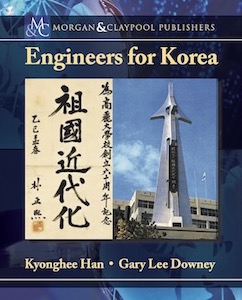
“The engineer is bearer of the nation’s industrialization,” says the tower pictured on the front cover.President Park Chung-hee (1917–1979) was seeking to scale up a unified national identity through industrialization, with engineers as iconic leaders. But Park encountered huge obstacles in what he called the “second economy” of mental nationalism. Technical workers had long been subordinate to classically trained scholar officials. Even as the country became an industrial powerhouse, the makers of engineers never found approaches to techno-national formation—engineering education and training—that Koreans would wholly embrace.
This book follows the fraught attempts of engineers to identify with Korea as a whole. It is for engineers, both Korean and non-Korean, who seek to become better critical analysts of their own expertise, identities, and commitments. It is for non-engineers who encounter or are affected by Korean engineers and engineering, and want to understand and engage them. It is for researchers who serve as critical participants in the making of engineers and puzzle over the contents and effects of techno-national formation.
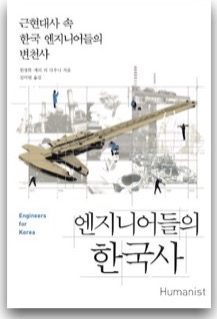
Named a 2017 Sejong Book by the Korean Ministry of Culture, Sports, and Tourism. Honors books that “have high value as academic texts and improve the public’s reading culture.” Carried an award of ten million Won ($8,900) to pay for distributing copies across the country.
Endorsements for Engineers for Korea
“This book is an in-depth study of and effective introduction to Korean engineering and engineers. It links the historical process of industrialization to the formation of engineers across Korea, differentiated from other countries. Not only engineering educators in Korea, but all other kinds of researchers and engineers who are interested in the Republic of Korea will be fascinated by the priceless information, knowledge, and great insights in this book.”
Kim Moon Kyum, Vice-President, Yonsei University; member, National Academy of Engineering in Korea; President-Elect, Korean Society of Civil Engineers
“This is a ground-breaking work that shows how two scholars from different countries can work together to achieve compelling results. The analyses of Korean engineers in the past and present that Han and Downey have woven together into a unique narrative are sure to evoke attention and curiosity, even sympathy, from readers all over the world.”
Lee Euy-soo, President, Korean Society for Engineering Education
“Through this remarkable book you can understand not only Korean engineers but also much about the country that has raised them. Korean politics, economy, and history have all been interconnected in Han and Downey’s account of the development of Korean engineers.
Lee Eun Kyung, Professor, Department of Science Studies, Chonbuk National University; Vice-President, Korean Association of Science and Technology Studies.
Contents
Ch1 What are Korean Engineers For? pdf
Ch2 Five Koreas without Korean Engineers: 1876-1960 pdf
Ch3 Technical Workers for Light Industry: 1961-1970 pdf
Ch4 Engineers for Heavy and Chemical Industries: 1970-1979 pdf
Ch5 Loss of Privilege and Visibility: 1980-1998 pdf
Ch6 Engineers for a Post-Catch-Up Korea? pdf
Ch7 Engineers and Korea pdf
What is Global Engineering Education For? The Making of International Educators
Morgan and Claypool Publishers, 2011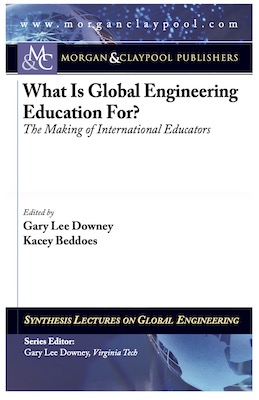
Edited by:
Gary Lee Downey, Virginia Tech
Kacey Beddoes, Virginia Tech
Morgan and Claypool Product Page
Global engineering offers the seductive image of engineers figuring out how to optimize work through collaboration and mobility. Its biggest challenge to engineers, however, is more fundamental and difficult: to better understand what they know and value qua engineers and why. This volume reports an experimental effort to help sixteen engineering educators produce “personal geographies” describing what led them to make risky career commitments to international and global engineering education. The contents of their diverse trajectories stand out in extending far beyond the narrower image of producing globally-competent engineers. Their personal geographies repeatedly highlight experiences of incongruence beyond home countries that provoked them to see themselves and understand their knowledge differently. The experiences were sufficiently profound to motivate them to design educational experiences that could provoke engineering students in similar ways.
Endorsements for What is Global Engineering Education For?
This unique publication provides compelling evidence of the benefits, both personal and professional, of infusing engineering education with international perspectives and experience abroad. It combines a set of fascinating personal histories from leading engineering faculty members and international educators with a thoughtful analysis of why our country, and every country, needs to produce engineers with the critical knowledge and self-awareness required to work effectively in international environments. The contents will inspire future engineers to step outside their ‘comfort zones’ early in their academic careers and should be required reading for every academic, industrial, and government leader.
-Dr. Allan E. Goodman, President and CEO, Institute of International Education
Through a series of engaging personal essays, this work challenges the reader to understand engineering as a discipline and a profession within a national context and then to broaden, or even re-cast, that understanding based on global commonalities and international distinctions. The reader is thereby provoked to use the personal journeys of self-discovery to help elucidate sign posts for the types of learning journeys we hope to motivate within our students. The end result may well be discovering how to guide the development of engineers in a world increasingly connected (and yet, separated) physically, socially, culturally, intellectually, emotionally, etc. and enhancing their ability to comfortably operate and thrive in such an environment.
-Dr. Norman L. Fortenberry, Director, Center for the Advancement of Scholarship on Engineering Education, National Academy of Engineering
The Machine in Me: An Anthropologist Sits Among Computer Engineers
Routledge, 1998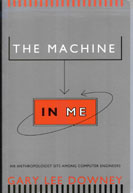
Gary Lee Downey investigates the body/machine interface in this remarkable ethnography of computer engineers. Drawing on interviews, observations, and personal interaction with engineers, he documents the everyday power of technology’s dominant image in our society, a force widely regarded as monolithically progressive. The Machine in Me helps us understand how deeply we and machines are configured through one another.
Front Matter pdf
Ch 1: Images Count pdf
Ch 2: We Put You in Control: The Trade Show
Ch 3: Does Productivity Fit?
Ch 4: Seducing Money
Ch 5: Adapting a Nation around Automation
Ch 6: Beyond Control and Submission
Ch 7: Locating Me Inside It: Coding
Ch 8: Locating It Inside Me: Confusion
Ch 9: The Making of Experts
Ch 10: On the Replacement of Humans with Machines: A Different Humanism pdf
Endorsements for The Machine in Me
“Engaged in earnest and honest dialogue with the engineers he studies and works with, Gary Downey shows us from the inside what working within a technology means to the lives of these scientists. Downey proposes – hope against hope – a vision of what a different world of technology and business might be. Admirable.”
– Paul Rabinow, University of California at Berkeley ”
Downey has produced a most provocative analysis of the still emergent culture of CAD/CAM – machine and maker, students and users – based upon extensive field work, often as a participant. More than an engaging ethnography, he provides a refreshing critique of contemporary social studies of technology and society, moving beyond networks, impacts, agents, and actors to author a most compelling story.”
– Louis Bucciarelli, Massachusetts Institute of Technology
Cyborgs and Citadels: Anthropological Interventions in Emerging Sciences and Technology
School of American Research Press, 1997
Edited by:
Gary Lee Downey, Virginia Tech
Joseph Dumit, University of California Santa Cruz
Interactions between humans and technology are omnipresent today and permeate all of our lives. Yet only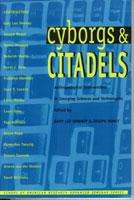 recently have these interactions been studied in cultural terms, as scholars have started to apply anthropological methods and theories to examine the practices and practitioners of contemporary science, technology, and medicine in the United States. This volume of essays is an important contribution to the exciting new anthropology of science and technology.
recently have these interactions been studied in cultural terms, as scholars have started to apply anthropological methods and theories to examine the practices and practitioners of contemporary science, technology, and medicine in the United States. This volume of essays is an important contribution to the exciting new anthropology of science and technology.
In Cyborgs & Citadels, some of this country’s most imaginative and influential thinkers explore such questions as how science gains authority to direct truth practices (the “Citadel” problem), the boundaries between humans and machines, and how science, technology, and medicine contribute to the fashioning of everyday lives and selves (the “Cyborg” problem). Their fieldwork sites include a prenatal sonogram clinic, an inner-city AIDS clinic, a molecular biotechnology lab, a conference on Marfan syndrome, a center for brain imaging technology, a particle physics lab, an undergraduate engineering program, and the School of America Research advanced seminar that gave rise to this volume. A special section titled “Corridor Talk” offers essential and hard-to-find advice on careers, publication opportunities, and grant writing for scholars of emerging sciences, technologies, and medicines.
Ch 1: Locating and Intervening: An Introduction pdf
Gary Lee Downey and Joseph Dumit
Ch 2: Real-Time Fetus: The Role of the Sonogram in the Age of Monitored Reproduction
Rayna Rapp
Ch 3: AIDS, Knowledge, and Discimination in the Inner City: An Anthropological Analysis of the Experiances of Injection Drug Users
Emily Martin, Laury Oaks, Karen-Sue Taussig, and Ariane van der Straten
Ch 4: Bodies, Antibodies, and Modest Interventions
Deborah Heath
Ch 5: A Digital Image of the Catagory of the Person: PET Scanning and Objective Self-Fashioning
Joseph Dumit
Ch 6: Iconic Devices: Toward an Enthnography of Physics Images
Sharon Traweek
Ch 7: Engineering Selves: Hiring In to a Contested Field of Education pdf
Gary Lee Downey and Juan C. Lucena
Ch 8: If You’re Thinking of Living in STS: A Guide for the Perplexed
David J. Hess
Ch 9: Ethnographic Fetishism or Cyborg Anthropology?: Human Scientists, Rebellious Rats, and Their Mazes at El Delirio and in the Land of the Long White Cloud
Sarah Williams, with Frederick Klemmer
Ch 10: Science as a Practice: The Higher Indifference and Mediated Curiosity
Paul Rainbow
Ch 11: Mice into Wormholes: A Comment on the Nature of No Nature
Donna J. Haraway
“Corridor Talk” pdf
Gary Lee Downey, Joseph Dumit, and Sharon Traweek
Endorsements for Cyborgs and Citadels
“A collection of first-order significance. Virtually all of the US scholars who have pioneered anthropology’s entry into the arena of science and technology studies are included. This will certainly be a landmark publication for anthropologists.”
– George E. Marcus, Rice University